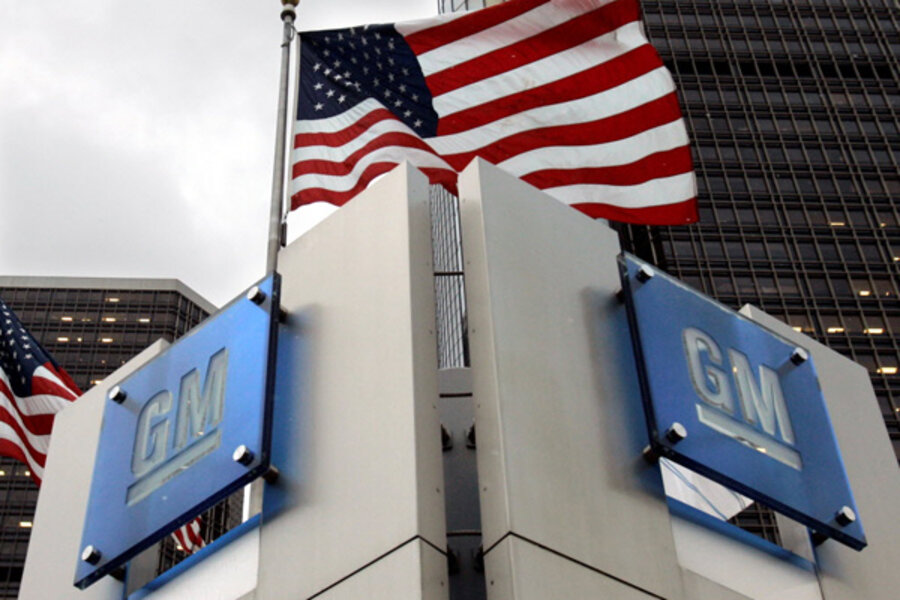One year after bankruptcy, General Motors predicts a profitable 2010
Loading...
| Chicago
General Motors is predicting it will enjoy its first profitable year in six years after reporting a $2 billion profit for the third quarter. The turnaround is expected to bolster the company’s stock, which GM plans to sell on the New York Stock Exchange next week.
The third-quarter results, announced Tuesday, are up 50.4 percent from the second quarter, when the company posted $1.33 billion in net income. Year-to-date earnings are $4.2 billion after taxes and interest.
One year after exiting bankruptcy, GM says it is on track to become profitable.
“As demonstrated by our third consecutive quarter of profitability and positive cash flow, these results continue our significant progress,” Chris Liddell, vice chairman and chief financial officer, said in a statement released Tuesday.
GM’s profits surpass rival Ford, which posted a $1.7 billion profit for the third quarter. Chrysler reported a net loss of $84 million.
GM’s numbers are expected to help the company as it aims to raise about $13 billion from investors in an initial public offering tentatively scheduled for Nov. 18. GM is hoping for between $26 and $29 per share, which would reduce the US Treasury Department’s stake in the company to below 50 percent.
To improve the value of its shares, GM announced in October it would pay down its debt and pension obligations by $11 billion. That includes $4 billion in cash and $2 billion in common stock that the company will contribute to its pension plans. Also, it plans to purchase $2.1 billion of its preferred stock from the US Treasury. Another $2.8 billion will be paid to a retiree medical trust run by the United Auto Workers Union.
Earlier this month, Standard & Poor’s, the corporate rating service, assigned GM a BB-minus credit rating, saying the IPO was “a positive for the company’s future capital-raising prospects.” This is the first time S&P has assigned a rating to the new GM since its emergence from bankruptcy. The BB-minus rating is considered two notches below investment grade.
GM’s 40-day bankruptcy last year resulted in a dramatic restructuring of the company. Unprofitable brands like Pontiac, Saturn, and Hummer were dropped from the lineup, its dealership network was cut by 40 percent, and majority ownership of the company was placed in the hands of the US Treasury.
The bailout, which earned GM the name “Government Motors” from critics, is covered in “Decision Points,” the memoir of former President George W. Bush, released this week.
In the book, Mr. Bush defended the $17.4 billion in federal money used to bail out Chrysler and GM because he realized he had to “save American workers and families from widespread collapse.” He added that he was first approached to bail out GM before the November 2008 elections by Rick Wagoner, then CEO of GM. Although Bush wasn’t open to the idea at first, he reversed his decision after realizing the magnitude of job losses and lost tax revenues.
He criticized GM and Chrysler for “decades of poor management” he said “had been slow to recognize changes in the market.”
Challenges remain for GM. The greatest one comes from overseas, which accounts for about two-thirds of its annual unit sales. The company’s Europe operations experienced a nearly $600 million loss in the third quarter, following a second-quarter loss of nearly $200 million. GM needs to do a better job marketing its cars to the European market, says CEO Dan Akerson. “We know we have much more work to do,” he said Wednesday in a conference call with the media.
In North America, GM is putting much of its marketing dollars behind the Chevrolet Cruze, an economy car, and the Chevrolet Volt, its plug-in hybrid electric car. Yet consumers may not yet be comfortable with making the leap to purchase an electric vehicle, industry experts say. The “range anxiety” – fear of being stranded without an electric charge – may prevent Volt sales from taking off until a more substantial electric charging grid is established in every region of the United States.





